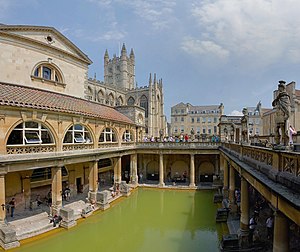Thermae

- This page is on buildings used for Roman bathing. For the activity in general, see Ancient Roman bathing.
The terms balnea or thermae were the words the ancient Romans used for the buildings housing their public baths.
Most Roman cities had at least one, if not many, such buildings, which were centers of public bathing and socialization. Baths were the most important for Romans. They stayed there for several hours and went there daily. They were accompanied by 1 or more slaves. When they paid their fee, they would strip naked and put on sandals to protect their feet from heated floors. The slaves carried around their masters towels and got drinks for them. After bathing, they exercised. They did things such as running, mild weight-lifting, wrestling, and swimming. After exercising, oil and dirt got scraped off by servants.
Roman bath-houses were also provided for private villas, town houses and forts — these were also called thermae.
Etymology
The word thermae is Latin borrowing from the Greek adjective thermos, therme, thermon (hot).
cf. Thermopylae (the hot gates, gates of fire) thermae sc. aquae means "hot waters, hot springs".
Building layout
Within the building there were three rooms (or three within each wing - one for each gender - after Hadrian's decree of separation in bathing):
- the caldarium (L. cal(i)dus, -a,-um "hot" cf. calor orig, calos, caloris m)
- the tepidarium (L. tepidus,-a,-um "lukewarm" cf. L. tepeo)
- the frigidarium (Latin frigidus,-a,-um "cold")
- sometimes there were also steam baths: the sudatorium — a moist steam bath, and the laconicum — a dry steam bath much like a modern day sauna.

Purpose
The baths often included, aside from the three main rooms listed above, a palaestra, or outdoor gymnasium where men would engage in various ball games and exercises. There, among other things, weights were lifted and the discus thrown. Men would oil themselves (as soap was still a luxury good and thus not widely available), shower,[citation needed] and remove the excess with a strigil (cf. the well known Apoxyomenus of Lysippus from the Vatican Museum). Often wealthy bathers would bring a capsarius, a slave that carried his master's towels, oils, and strigils to the baths and then watched over them once in the baths, as thieves and pickpockets were known to frequent the baths.
The changing room was known as the apodyterium (Greek apodyterion, apo + duo "to take off" here of clothing).
Cultural significance
The baths were an important place in the lives of Romans. Built as public monuments, they were used by everyone, whether rich or poor, free or slave. A person could eat, exercise, read, drink, shop, socialize, and discuss politics. The modern equivalent would be a combination of a library, art gallery, mall, bar/restaurant, gym, and spa.[1]
When asked by a foreigner why he bathed once a day, a Roman emperor is said to have replied "Because I do not have the time to bathe twice a day." [2]
Emperors often built baths to gain favor for themselves and to create a lasting monument of their generosity. If a rich Roman wished to gain the favor of the people, he might arrange for a free admission day in his name. For example, a senator hoping to become a Tribune might pay all admission fees at a particular bath on his birthday to become well known to the people of the area.
The piping in Roman Baths were constructed out of lead. [3]
Location
Baths sprung up all over the empire. Where natural hot springs existed (as in Bath, England, and Băile Herculane) thermae were built around them. Alternatively a system of hypocausta (Greek hypocauston < hypo "below" + kaio "to burn") were utilized to heat the waters heated by a furnace (praefurnium)
Remains of Roman public baths
Algeria
- Timgad
- Guelma (ancient Calama)
- Héliopolis
- Hammam Meskoutine (ancient Aquae Tibilitanae)
- Hammam Righa (ancient Aquae Calidae)
Bulgaria

- Kyustendil (ancient Pautalia)
- Varna (ancient Odessus)
United Kingdom
- Bath - Roman Baths
- Exeter, Devon
- Leicester - Jewry Wall
- Tripontium, near today's Rugby, Warwickshire
- Vindolanda, Little Chesters, near Hadrian's Wall
- Welwyn, in Hertfordshire
France
- Arles - Thermes de Constantin
- Glanum, near today's Saint-Rémy-de-Provence
- Paris - Thermes de Cluny
Germany
Hungary
Italy
Romania
Spain
The Netherlands
Lebanon
Military bathhouses
UK
Villa bathhouses
UK
See also
References
- Aaland, Mikkel (May 15, 1998). "Mass Bathing: The Roman BaInea and Thermae". Cyber-Bohemia. Retrieved August 2.
{{cite web}}: Check date values in:|accessdate=(help); Unknown parameter|accessyear=ignored (|access-date=suggested) (help)CS1 maint: year (link)
External links
- ThermeMuseum (Museum of the Thermae) in Heerlen
- Traianus - Technical investigation of Roman public works
